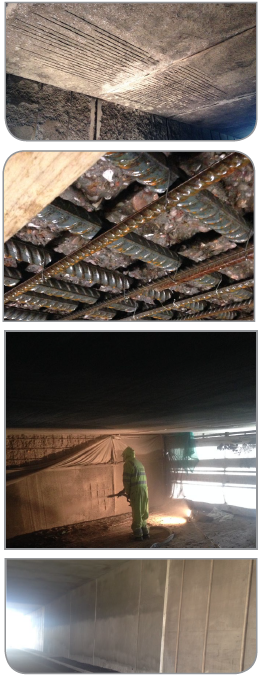 Fire Damage Repair
Fire Damage Repair
Client
M6 Toll
Value
£250,000
Works Commenced
May 2014
Works Completed
July 2014
Significant structural damage occurred to the M6 Toll at Dunton Lane under-bridge following a lorry fire. The M6 Toll engineering team contacted Freyssinet to assist with the assessment of the fire damage and work with its design team to produce a suitable repair strategy.
Following technical approval of the fire damage repair solution, works commenced on site. The approved repair design consisted of a series of sequenced repairs to the soffit. The repairs were arranged in a ‘patchwork’ layout, with the intention to remove only a small area of defective concrete from each structural element at any juncture, thus ensuring the integrity of the structure was not put at risk. Once the soffit repairs were complete, Freyssinet undertook wall repairs as the second phase of the works.
Due to the large volume of concrete repair, hydro-demolition was used for the concrete removal. A mains water supply was located some 500metres away from the work area. Due to low flow capacity of existing mains water supply, water storage tanks were used to store the ‘trickle’ supply from the main over 24/7 period throughout the contract period. 60m3 of water was stored at all times.
A scaffold system was erected to provide unrestricted access to the soffit repairs. In order to facilitate the clients key dates for re-opening of the M6 Toll, it was necessary to install a central dividing screen on the scaffold. This allowed hydro-demolition to be undertaken on the east side of the structure whilst spray concrete was being undertaken concurrently on the west side. This made significant time savings to the overall scheme and ensured that the M6 Toll was re-opened in a timely manner.
Water produced during the hydro-demolition process was treated on site prior to discharge into the adjacent storm drainage network. The Environment Agency provided consent to discharge prior to the commencement of the works. The water was filtered through geotextile before being PH tested and balanced to PH6-9 before discharge. Following the completion of the hydro-dem process, timber battens were installed to line and level by the joiners prior to spray concrete application.
During the sprayed concrete process, as a consequence of the attention to detail and competence of the spray concrete team, a very high level of quality was achieved with no voids at edges of repairs or behind reinforcement.
The southern side wall of the structure had sustained surface damage during the fire, but due to the depth of the reinforcement (approx 85mm of cover) there had not been any significant structural damage/exposure of reinforcement to the south wall. The main function of the wall repairs was to restore a suitable ‘finish’ to the concrete surface. The conventional method of undertaking spray concrete repairs is to expose the existing reinforcement in order to allow the spray concrete to bond behind the bars and provide sufficient integrity of the repair. Due to the depth of the reinforcement, it was not cost effective to remove the concrete behind rebar, so Freyssinet suggested that the existing concrete was treated with surface preparation by hydro-dem methods to provide a rough surface (CSP 6) which would allow spray concrete to bond to the substrate. A layer of reinforcement was then introduced to the outer surface of the parent concrete in the form of A393 mesh drilled held in place with drilled and resin fixed 16mm L-bars.
Once the rebar was fixed, timber battens were installed to line and level by the joiners prior to spray concrete being applied. When the sequenced wall repairs were complete, a ‘flash coat’ of spray concrete was applied to the walls and soffits in order to achieve a uniform textured finish. This was mainly for aesthetic reasons to cover the construction joints.
Whilst the north wall of the structure had not sustained a large amount of damage, there were a limited amount of localised repairs that were treated using flowable repair concrete methods rather than spray concrete. Hydro-demolition was used again to remove the defective concrete from the areas requiring repair.
